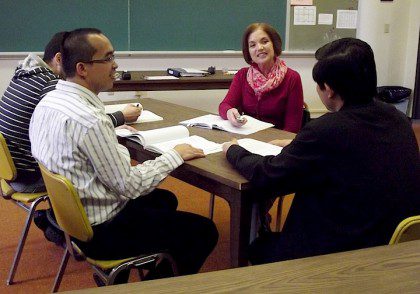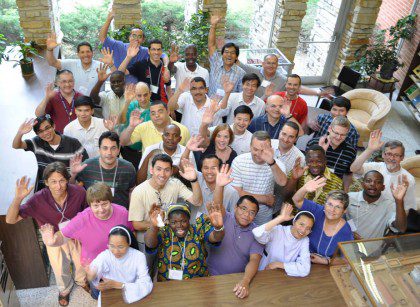
New SHST program helps students not only learn English, but be understood in it as well
A person can have a dictionary’s worth of words in his head, but to really be fluent in a language one also needs to be understood.
“It’s a shame to hear ‘We love Fr. Jacobs, he is great with youth and he has such a wonderful smile. It’s just too bad we can’t understand his homilies.’”
The quote comes from a member of the Sacred Heart School of Theology staff, but as the Church in the United States becomes increasingly multicultural, some version of the phrase can be heard in churches throughout the country.
Parishioners are grateful for their international priests but also frustrated when they can’t understand them well.
“People will sometimes not go to Mass if they know that the celebrant is a priest they can’t understand,” added the SHST staffer. “Not being able to fully communicate is a huge impediment to ministry.”
Sacred Heart has hosted an ESL (English as Second Language) program for over 25 years. Well respected around the world, the program focuses on teaching English to those who will be using it in a church context. Students learn the terminology and nuances needed in parish ministry and other religious environments.
The ESL program is very concentrated. “The students are here to learn as much English as they can in a short period of time,” said Kelly Kornacki, ESL academic coordinator.
It’s concentrated, but it is also an effective program; students often arrive with only a handful of English words but within a few months can generally read and comprehend the language well.
However, understanding a new language is only half the battle in learning it.
“There are seminarians who have completed ESL and are proficient in their reading and writing skills but might be difficult to understand during a course presentation,” said Kelly. “Of course, looking ahead a few years, it stands to reason that they will be difficult to understand during confessions, a homily and other pastoral work.”
Seminary concern
It’s an issue that SHST staff –– not just the ESL department –– have discussed for several years “but no one really knew how to address it,” said Kelly. Like many other ESL programs, Sacred Heart’s has had pronunciation classes “but not accent modification.”
Accent modification –– also known as “accent reduction” –– is generally not a part of a standard ESL curriculum.
“Usually accent modification teachers have their own private practice, do their own advertising, and often use one-on-one delivery,” she said.
Pronunciation and accent modification might seem like very similar concerns but each is unique and requires a very specific approach.
Everyone has an accent, but some accents affect pronunciation of a word to the point that it is not understandable to the average listener.
Accent modification works to “remove the distractions that impede comprehension,” said Kelly. The specific way a person speaks will remain uniquely individual. “It is still possible to hear inflections of a native tongue, yet they are softer, milder, and don’t impede understanding.”
Being understood is vital
“When it became apparent to me that something more needed to be done to assist the students in being understood I did further research on the topic,” said Kelly. “One program kept coming up on my radar, the methodology seemed very sound, the reviews were great, and the promised results were beyond my best hopes. The name of the program is ‘Compton’s P-ESL’, or ‘Compton’s Pronouncing English as a Second Language.’”
During the 2012 Christmas break Kelly went to Las Vegas for intensive training in the program. Back home she spent the rest of her break familiarizing herself with the materials, transcription methods, and other pieces of the program.
When the break was over and the spring semester started, SHST had an accent modification class on its schedule for the first time. “It was also the first time that I taught such a class!” said Kelly.

There were 11 students. “We did not open the first class to seminarians,” said Kelly. “Rather, we had the advanced ESL students who were preparing for further studies take the class. The ability to communicate orally would be important to them as they prepared for MAs, M.Divs and other work.”
Describing the class, Kelly said that at first, there is a very generic approach for everyone.
“We start by reviewing phonemes [the smallest sound found in a word; basically, the tiny building blocks that form a word orally] from the previous week’s lesson,” said Kelly. “Next, we move on to sound differentiation. For example, I might say, ‘Bless, blessed,’ and the student has to tell me if the words are the same or different.
Kelly said that the tasks may sound monotonous “but we really have a good time as everyone makes mistakes so we laugh with each other to make it a comfortable environment.
“Sometimes a mispronunciation changes the meaning of a word into something funny or totally inappropriate. Of course, that’s also a great moment to point out why correct pronunciation is vital!”
Also, when the students preview the words they will be repeating, they have the opportunity to ask for definitions. “This is one of my favorite components of the class,” said Kelly. “It’s surprising how frequently a word I thought would be strange to them is one they already know, yet a commonly used word is one that is unfamiliar. We have some truly great dialogue during this part of the lesson.”
Kelly emphasized that while there is a standard approach to the class, the program itself is extremely individualized.
“Each student records words, sentences, a passage, and free speech, which I then transcribe,” said Kelly. “Errors are recorded and analyzed for rate of occurrence. This makes each student’s lesson plan unique; each class has no more than five students at a time.”
There are already seven people signed up for the fall session. “Some are seminarians who heard of the program and want to make themselves more understandable to English speakers,” said Kelly. Others include ESL students moving into advanced studies. Vocation directors are excited about the program.
Besides the on-site classes, Kelly is also looking at distance learning, teaching the class through Skype. “This would be especially helpful for people who are not students at Sacred Heart,” she said. “The program is open to anyone, not just SHST students.”
Does it work?
“That’s the most important question,” said Kelly. “That’s what vocation directors and bishops want to know, and that’s what potential students themselves are concerned about.”
Typically, the standard rule is that a student who does the suggested practice time outside of class should expect to see a 50% improvement in his or her ability to be understood by others.
“However, our actual results have been much higher,” said Kelly. “In fact, I have just finished transcribing the students’ end-of-session recordings, and the average is an 82.8% improvement.
“When I realize how over-scheduled this first class of students was I am thrilled at their accomplishments!”
For information about Sacred Heart School of Theology’s ESL or accent modification classes click here.

